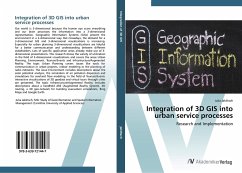Our world is 3-dimensional because the human eye scans everything and our brain processes the information into a 3-dimensional representation. Geographic Information Systems (GISs) present the environment in a 2-dimensional way. But nowadays, the demand for a 3-dimensional GIS and 3-dimensional visualizations is increasing. Especially for urban planning 3-dimensional visualizations are helpful for a better communication and understanding between different stakeholders. Lots of specific application areas already make use of 3-dimensional presentations. This research shows the variety of utilization in the field of 3-dimensional visualizations and covers the areas Urban Planning, Environment, Tourism/Events and Infrastructure/Augmented Reality. The topic Urban Planning covers issues like tools for communication in urban projects, indoor modeling or the planning of radio networks. The issue Environment includes descriptions about the solar potential analysis, the simulation of air pollution dispersion and simulations for overland flow modeling. In the field of Tourism/Events interactive visualizations of 3D geodata and virtual tours through cities are presented. The topic Infrastructure/Augmented Reality includes descriptions about a handheld ARS (Augmented Reality System), 3D routing, a 3D geo-network for building evacuation simulations, Bing Maps and Google Earth.

